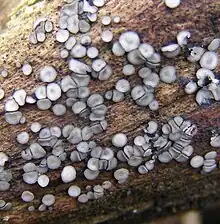Mollisiaceae
Mollisiaceae is a family of fungi in the order Helotiales. It contains almost 800 species in 17 genera with multiple genera remaining undescribed.[1] Saprotrophs and root endophytes are prominent in the family but it also includes endophytes of other plant tissues.[2] Due to a lack of accessible morphological features, the family has been difficult to study resulting in limited understanding of its taxonomy. Genetic studies suggest that the family comprises much overlooked biodiversity.[2]
| Mollisiaceae | |
|---|---|
 | |
| A fungus of the genus Mollisia | |
| Scientific classification | |
| Domain: | Eukaryota |
| Kingdom: | Fungi |
| Division: | Ascomycota |
| Class: | Leotiomycetes |
| Order: | Helotiales |
| Family: | Mollisiaceae Rehm |
Genera
- Barrenia E.Walsh & N.Zhang, 2015 (3 species)
- Bulbomollisia Graddon (3 species)
- Cystodendron Bubák (11 species)
- Discocurtisia J.A.Nannfeldt, 1983 (1 species)
- Mollisia (Fr.) P.Karst., 1871 (411 species)
- Neotapesia E.Müll. & Hütter (3 species)
- Niptera Fr., 1849 (80 species)
- Nipterella Starbäck ex Dennis (4 species)
- Phialocephala W.B.Kendr. (152 species)
- Pseudonaevia Dennis & Spooner (2 species)
- Pyrenopeziza Fuckel (221 species)
- Sarconiptera Raitv., 2003 (1 species)
- Scutobelonium Graddon (2 species)
- Scutomollisia Nannf. (15 species)
- Tapesia (Pers.) Fuckel (121 species)
- Trimmatostroma Corda (42 species)
- Variocladium Descals & Marvanová (3 species)
References
- "Mollisiaceae". Global Biodiversity Information Facility. Retrieved 29 January 2023.
- Tanney, J.B.; Seifert, K.A. (2020). "Mollisiaceae: An overlooked lineage of diverse endophytes". Studies in Mycology. 95: 293–280. doi:10.1016/j.simyco.2020.02.005. PMC 7426276.
This article is issued from Wikipedia. The text is licensed under Creative Commons - Attribution - Sharealike. Additional terms may apply for the media files.